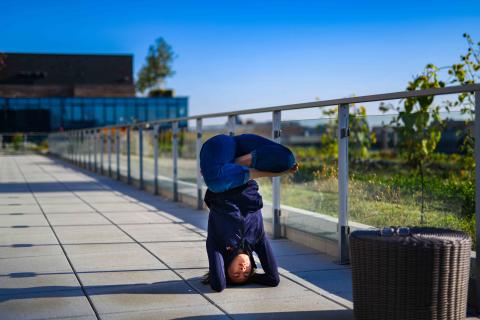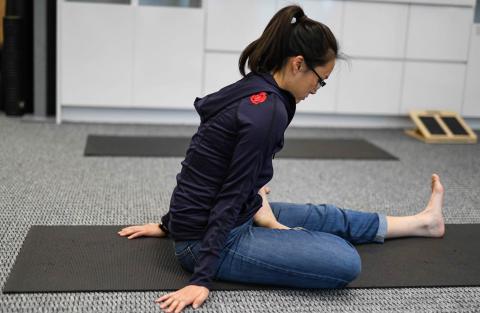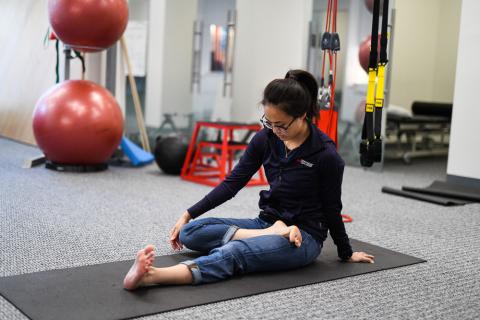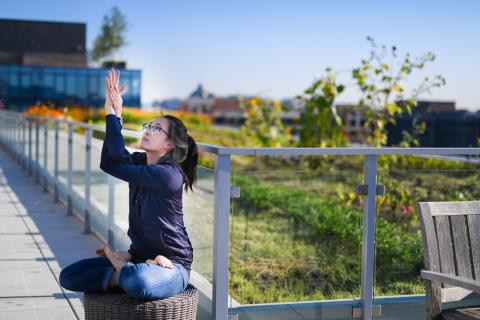Lotus pose is a great hip opener that feels good during both meditation and inverted poses. However, performing the lotus pose, known amongst yogis as padmasana (the ultimate pose), is an advanced posture and can cause more harm if performed without warming up properly. Since we have offered yoga in the District for the past year at our Navy Yard location, I wanted to provide my perspective on performing this advanced pose.
The yoga lotus position is a meditative stretch in which the feet are placed on the opposing thighs. It is an active stretch that targets the hips, but it can be challenging for beginners. The four steps I use to achieving a lotus pose are:
- Warming up my hips with stretching
- Performing test stretches before attempting the position
- Protecting my knees and ankles from potential injury
- Practicing the opposite position to achieve balance
I find a lot of peace with being upside down and my legs folded up into a lotus. When I first saw my yoga instructor in padma pincha mayurasana, lotus forearmstand, I thought it was the most beautiful shape I’ve ever seen. I tried by myself and my legs immediately cried out in protest - my ankles felt like they were going to snap! It was years before for me to comfortably get into padmasana, the lotus position, and even longer to attempt it upside down.

I know I have done my preparation right when my legs feel secure and strong. A few things that I do to make sure my inverted lotus is an injury-free success include:
1. Warm up my hips - a lot. The preparation poses leading up to a lotus are important for me to make sure my hips are ready. My most productive stretching sessions happen after a long workout, whether that means a cardio session, or a rough jiu-jitsu class. My rule of thumb is: if I’m sweating profusely, I have a chance at trying a lotus.

2. Preparation stretches: Padmasana can place the hip in a rather vulnerable position for injury. To see if I have enough flexibility, I first sit on the floor and cross one ankle over my other knee. Is my right heel comfortably sitting in my left hip crease? Is my right knee touching the floor? If yes to both questions, my hips are open enough.
3. Protecting my knees and ankles. This step is so important that I unfortunately learned the hard way. I used to skip steps 1 and 2 and my ankles would feel very sore afterwards. If your hips aren’t open enough, the lotus pose puts a lot of twisting pressure on the knees and ankles that isn’t good long term. One thing I do when I get into position is to dorsiflex my ankles, or pulling my feet back towards my knees. This stretches the gastrocnemius, a calf muscle that crosses both the knee and ankle joint and helps stabilize both.

4. Practice both ways. It’s like clasping your hands with your other thumb on top - it feels weird, but I have to do it. It’s really easy in yoga, and any sport, to favor one side. But this sets a person up for muscle and mobility imbalances, and therefore injury. There have also been many studies that demonstrate that if you practice on your “weaker” side, the other side will become even better.
Padmasana is a pose that brings me a lot of peace and makes me feel so strong, and I want to keep doing it for a long time. The pose is challenging and some days it just doesn’t happen, but when it does it makes me so happy - that’s worth the extra prep for me!

Rose Physical Therapy is currently offering yoga classes at the Capitol Riverfront/Navy Yard location on select evenings. Singups are through Capitol Hill's Realignment Studio, who lead the classes. It's just a block from the Navy Yard metro in Southeast DC, so convenient to get to and also for post class fun at Nats games or enjoying everything the Capitol Riverfront and Capitol Hill have to offer.


